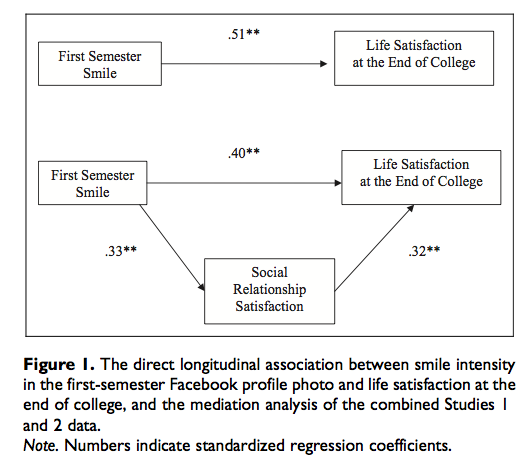If you’re not smiling in your Facebook photo, your life is probably going to suck in four years time.

Reseachers J. Patrick Seder and Shigehiro Oishi at the University of Virginia in Charlottesville discovered that smile intensity from a single Facebook profile photo in the first semester of college predicted self-reported life satisfaction three and a half years later, at the time of college graduation.
This type of study isn’t actually unique to Facebook, however. A 2011 study by Harker and Keltner showed that female students smiling in their college graduation yearbook photos from 1958 and 1960 were reportedly happier 30 years later. A similar study by Abel and Kruger (2010) found that professional baseball players who smiled more intensely in archival photos lived seven years longer than those who didn’t smile much.
Why does intensity of smiling in a photo predict well-being later in life? Smile intensity is associated with life satisfaction. But what about extroversion? This is another, third variable that the researchers considered.
People who smile more in their public Facebook photos tend to have better social relationships. Past research, which the study thoroughly references, shows that people who smile in photos are generally warmer and friendlier than their sad face counterparts. The smilier they are, the easier time they have with social relationships. Heightened smiling intensity in said photos correlates with greater life satisfaction, mostly through good relationships with others.
Wait, but what about extroverts? The researchers found that smile intensity did not significantly correlate with self-reported extroversion. Of the subjects they studied, they did, however, find that first-semester social relationships satisfaction (when the study began) was an important link between smile intensity and future self-reported life satisfaction. So just because someone appears extroverted on Facebook doesn’t mean they’re satisfied – it just means that they’re extroverted and so they probably know lots of people.

One caveat to the study (specifically study one): Researchers worked with students who were college freshmen in the fall 2005, and used Facebook when it became available to most colleges. In September 2006, Facebook became available outside of the academy. The first study worked with 92 participants (35 male), which is a rather small sample size. All study 1 participants are Facebook early adopters.
















